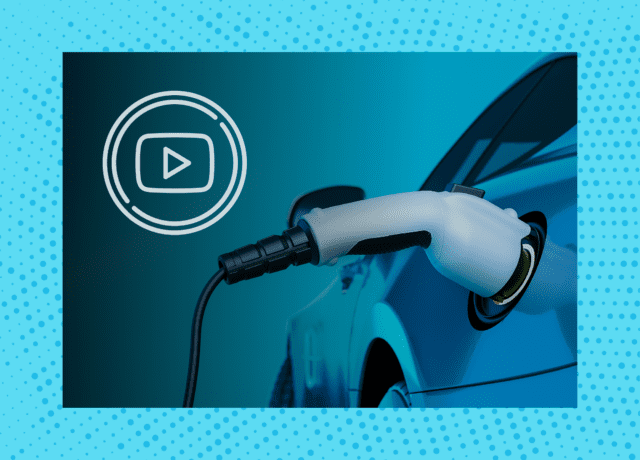Want to hear something crazy?
The first electric vehicle (EV) debuted in 1889. It was the brainchild of a Scottish immigrant, William Morrison, and nothing more than a battery-powered carriage. It was enough, however, to spark an interest in EVs that’d last for generations.
The EV industry looks radically different than it did when Morrison and his contemporaries ushered in the electric revolution; how companies promoted EVs looks a lot different, too—look at this ad from the Riker Motor Vehicle Company straight out of 1900.
Today, EV manufacturers are innovating faster than ever. The Tesla Roadster goes 0-60 in less than two seconds. The Lucid Air can go from NYC to Detroit on one charge. And electric vehicle advertisers are embracing the best that YouTube has to offer.
Electric Vehicle Advertisers Drive YouTube Ad Spending
Through April 2023, automotive advertisers promoting models and brands, motorcycles, aftermarket parts, and accessories spent almost $225mm on YouTube, up 100% YoY from the $112mm spent through April 2022.

More than 60% of that investment came from advertisers at four industry giants—General Motors (down by 24% YoY), Hyundai (up by 152% YoY), Nissan Motors (up by 288% YoY), and Volkswagen Group (up by 425% YoY)—who collectively increased spending on YouTube by 100% through April. More than $85mm of that investment went to ads playing on channels related to kid’s education and entertainment, music, society & culture, automotive, and gaming.
Almost 75% ($255mm) of that investment came from advertisers promoting models, including EVs, SUVs, and imports and domestics. The most significant increase in spending, however, came from EV advertisers.
Through April, YouTube spending to promote EVs was up by 800% YoY to $136mm (53% of YouTube spending on automotive models), which isn’t surprising considering the sales of electric cars are set for another record-breaking year.
After selling more than 10mm EVs in 2022, sales are expected to soar by another 35% this year and take their market share to 18%, up from 4% in 2020.
International Energy Agency’s (IEA) Executive Director Fatih Birol said, “Electric vehicles are one of the driving forces in the new global energy economy that’s rapidly emerging—and they’re bringing about a historic transformation of the car manufacturing industry worldwide.” He continued, “The trends we’re witnessing have significant implications for global oil demand.
The internal combustion engine has gone unrivaled for over a century, but electric vehicles are changing the status quo. By 2030, they’ll avoid the need for at least 5 million barrels a day of oil. Cars are just the first wave: electric buses and trucks will follow soon.”
Advertisers for oil and gas companies are undoubtedly paying attention after a hectic few years that saw the demand for their products soar and then come back to normal.
Advertisers for Hyundai were big contributors to the surge in EV advertising so far in 2023, spending more than $94mm on online video (OLV) ads to promote their new Ioniq 6.
“With the introduction of the IONIQ 6, Hyundai is once again making the electric vehicle lifestyle more accessible and convenient than ever before,” said Hyundai’s CMO, Angela Zepeda. “If you’re someone on the fence of going electric, we hope this campaign starring Kevin and Sosie Bacon will show how early adopters, at any stage in their life, can easily make the switch.”
The campaign, which launched on January 29 during the NFL’s Conference Championships, centered around two hero spots, “Your Dad Is Going Electric,” featuring the Bacons. The campaign also featured a 30-second spot, “Grandkids,” highlighting the environmental benefits of EVs.
The ads ran through March across broadcast and digital media platforms, including social, YouTube, TikTok, Twitter, Facebook, and Instagram.
Advertisers at Hyundai also invested heavily in YouTube to promote their SUVs, including the Hyundai Tucson and Kia Niro, which both come in hybrid models. Overall, SUV advertising increased by 19% YoY through April of this year.
Other legacy players invest in EV advertising on YouTube
Advertisers at Hyundai aren’t the only ones investing in YouTube. Advertisers promoting domestic models (all categories) increased their investment in YouTube by over 100% YoY to 18.6mm, thanks largely to increases from advertisers from Stellantic (Dodge, Jeep, and RAM) and General Motors, who increased spending by 1,000% and 200% YoY, respectively.
While their investments went largely to non-EV models, that could change quickly as legacy players dive deeper into all things electricity. Many of these advertisers will find themselves promoting EVs in short order.
For example, Dodge unveiled its first electric car less than a year ago. Despite that, CEO Tim Kuniskis said he’s not getting into the EV business. “I’m not going to try to sell anyone an electric car. I will never market an electric car.” Time will tell.
Meanwhile, Jeep announced its plan to launch two EVs in North America by 2025 (Jeep Recon and Wagoneer S) and one in Europe next year.
GM is making moves as well. In fact, the company sold more than 20,000 EVs in the first three months of 2023. But they’re not resting on their laurels.
In June, GM and Ford announced their EVs would now work with Tesla’s superchargers. Also in June, GM and Samsung announced plans to build an EV battery plant, which will undoubtedly boost production and warrant more ad dollars for the foreseeable future.
We’re Not Totally Electric…Yet
If the IEA’s forecast for EV sales is correct—sales growth of 35%—the market share of electric vehicles will reach 18% this year, up by 4% in 2020. What’s more, impending auto-pollution rules put forth by the Biden administration aim to ensure that all-electric cars make up as much as 67% of new passenger vehicles sold in the US by 2032.
A fully electric future is coming, but we’re not there yet.
Until then, ad spending from the non-EV corners of the automotive industry will continue. Through April, advertisers from Honda (+85% YoY), Nissan (+950% YoY), and Toyota (+770% YoY) all increased their investment in YouTube to promote imported models.
For more insights, sign up for MediaRadar’s blog here.


